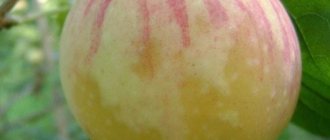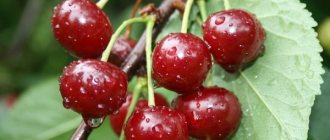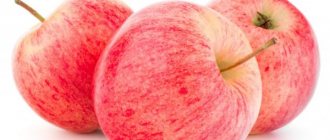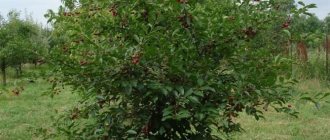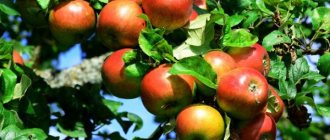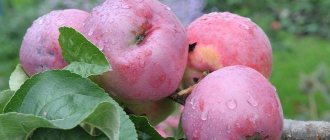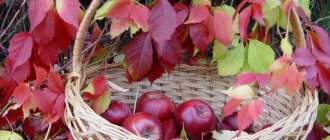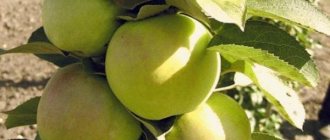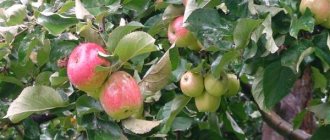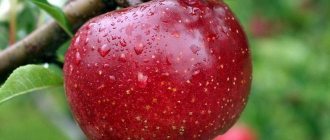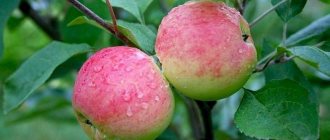Characteristics of the Melba variety
The apple tree is an early summer variety that produces a rich harvest. It is demanding regarding growth conditions. The tree is more often found in the southern regions and central Russia, in Europe.
Appearance
Melba has an average height and does not exceed 4 m. The wood is characterized by a hard, thick bark with red and yellow splashes. A young apple tree grows quickly, but after 8 years the process slows down. The crown has a medium degree of spreading, rounded. Its diameter does not exceed 7 m. The branches of medium thickness are slightly lowered.
The leaves are light green in color and elongated in shape. The flowers of the tree are large, and the shade of the petals is pink or pink-white. Tall species can live up to 45-50 years, semi-dwarf species - 20, in a dwarf rootstock - up to 15.
Taste characteristics of apples
The fruits weigh 120-150 g, although larger specimens are found. They have soft and juicy white flesh. The apple tastes sweet with a caramel aroma. On the tasting scale it has a rating of 4.5 out of 5 points. The skin is not rough, but dense and smooth. It is often green-yellow, but there are also red stripes.
Pollinator varieties
According to the standard description, the plant has a low ability to self-pollinate. It is recommended to be planted next to the following trees: Borovinka, Antonovka, Quinti, Papirovka, Vista Bella, James Grieve.
Resistance to diseases and pests
Melba is not resistant to pests and diseases such as powdery mildew and scab.
Winter hardiness and drought resistance
This fruit crop is a summer variety with early fruit ripening. It is not common in Siberia and other northern regions, because it has low frost resistance. In winter, the plant requires proper protection or it will die. The plant does not like high humidity, but during dry periods it needs to be watered.
Fruit ripening time
Apples become fully ripe in the second half of August. The process is extended over time, so fresh fruits can be removed from the tree within 30-45 days.
Fruiting and productivity
Melba begins active fruiting 3-4 years after planting. The apple has a round, slightly elongated, but flattened shape. The variety has a high yield level (50-80 kg per plant). At an early age it bears fruit annually, but then the process occurs periodically.
Area of application of fruits
The fruits are used for domestic and industrial purposes. The fruits are used to make jam, preserves, compote, various canned goods, and dried fruits. Juice, wine, and apple cider vinegar are produced on a factory scale. The grated pulp can be stored in the freezer without losing its taste.
Advantages and disadvantages of the variety
The variety has the following positive qualities:
- fast growth;
- early fruiting period;
- high degree of productivity;
- good taste;
- wide range of applications on the farm.
But there are also disadvantages:
- poor resistance to diseases and pests;
- the need for pollinating plants;
- frequency of fruiting at a late age;
- exposure to the negative effects of frost.
Advantages and disadvantages
Advantages of the Melba variety:
- early appearance of the harvest (the first apples can be collected 4 years after planting the seedlings in open ground);
- high yield of the variety;
- apples have a very bright appearance;
- The fruits store well if storage recommendations are followed.
Disadvantages of the variety:
- does not tolerate low temperatures;
- exposed to the negative effects of fruit scab disease and leaf disease - powdery mildew;
- with age, the number of apples decreases and fruiting periodicity appears;
- For a good harvest, apple trees require pollinators.
Varieties of Melba
Today, breeders grow not only the standard variety of apple tree, but also its other varieties:
- Melba's daughter. The plant looks almost the same as the mother form, but has increased resistance to frost and disease. The fruits are juicy and tasty, but have a short shelf life. To increase productivity, pollinating trees are required.
- Melba Ed. Bright red fruits are larger in size. Less commonly affected by insects and diseases.
- Cherished. The variety was bred in domestic laboratories. It has increased resistance to pests and negative external factors. The apple tree is early winter, so in good storage conditions the fruits last until the beginning of spring.
- Early aloe. The variety was selected in 1998 by domestic specialists. It has high resistance to damping, desiccation, and frost. Requires the presence of pollinating plants. The fruit of the tree is the same as that of the mother form.
The Prima variety, which was developed by American breeders, is considered popular. Its main advantage is resistance to scab.
Description
As already mentioned, the Melba apple variety is one of the oldest today. It was known about it back in the 19th century, and the variety appeared in Ottawa, Canada. The variety was named in honor of the Australian opera diva, whose work the breeders were fond of.
The tree does not grow too tall in height; in adulthood its crown has a spherical shape, in a younger age it is columnar.
Apple tree Melba
The Melba apple tree has a unique size of fruits: very large. Some specimens reach 150-190 grams. The shape of apples is characteristically round, the peel has a light glossy tint. The shape of the fruit is characterized by slight ribbing, which in no way detracts from its taste and external decorative properties.
The color of the peel is greenish, when ripe it is yellow-red. The pulp is very juicy, pleasant white in color. The taste of Melba is very interesting - sweet with a slight sourness, having a distinct caramel flavor. Thanks to this dessert taste, apples of this variety are very good both fresh and as a raw material for jams, preserves, preserves and other preserves. In addition to the excellent taste, the fruits of the Melba apple tree also have a very beautiful appearance. This fact significantly increases the marketable value of apples.
The Melba apple tree usually produces its harvest from mid-August to mid-September. But if you plan to store apples fresh for a long time, it is recommended to remove them a little unripe and then immediately place them in the refrigerator. Ripe Melba fruits do not stay fresh for too long.
The tree begins to bear fruit in the third or fourth year after planting. Every autumn, approximately 85 kg of fruit can be harvested from an adult tree, however, in the “advanced” age of the apple tree, the yield decreases.
The video shows a description of the apple tree variety:
It should be noted that the tree is not winter-hardy - it is better to grow Melba in warm climates. In addition, the disadvantages include the instability of the apple tree to scab disease. In addition, the tree has poor self-pollination and sometimes skips fruiting periods.
Features of planting an apple tree
Proper planting and care of a plant is the key to a rich and high-quality harvest. It needs to be fed, watered if necessary, the crown trimmed and protected from diseases and pests.
Dates and place
Early autumn or spring is the optimal time for planting Melba. If the first option is chosen, then the work must be carried out a month before the onset of the first frost: late September - early October. This period is good because roots damaged during planting have the opportunity to recover over the winter. If in cold times the temperature drops below -20 degrees, then the process is carried out in early spring, before buds form on other fruit crops.
When choosing a location, you need to pay attention to loamy soils with a normal level of acidity. Here groundwater should not be close to the surface, as it can wash away the roots and lead to the death of the tree. In the presence of spring floods, channels are dug from the seedling to drain excess moisture.
Selection of seedlings
Only strong and healthy Melba apple tree seedlings that meet the following requirements are suitable for planting:
- age - 1-2 years;
- height - 50-80 cm;
- the presence of 2-3 side shoots;
- well-formed root system.
2 days before work, the roots should be placed in a container with water. Immediately before landing, they are dipped into a clay mash.
Preparation and planting
A few days before planting the apple tree, you need to prepare a hole. Its depth is 60-80 cm, and its diameter is 1 m. If the soil is clayey or heavy, then a drainage layer of broken brick, pebbles or crushed stone should be laid at the bottom of the pit. Its thickness is 10-15 cm.
To retain moisture on sandy soil, a clay layer is required. The thickness here is 10 cm. The soil selected from the pit should be mixed with manure (compost), sand and peat. All components are taken in equal proportions.
The planting process itself involves the following steps:
- A small hill is built in the center of the hole. And at a distance of 10 cm from this place, a wooden stick is driven in, the height of which is 1-2 m above the soil level.
- The roots of the prepared seedling are treated with Heteroauxin powder.
- The tree's root collar is placed on a hill. After this, the roots need to be fluffed and straightened.
- Backfill. This must be done by periodically compacting the soil, but compacting it is prohibited. The root collar should be above ground level. At this stage, the seedling needs to be shaken slightly so that no air cavities remain between the roots.
- Tying up the plant.
- Formation of a trunk circle. This must be done according to the diameter of the hole.
- Watering. After completing the previous steps, abundant watering is required: you need to dissolve 5 g of Kornevin in 5 liters of liquid and pour it into the tree trunk circle.
After 2 days, the soil should be loosened and mulched with straw or hay. If it is planned to plant several trees, then the distance between them should not be less than 7-8 m.
Plant care rules
The set of measures includes periodic feeding of the plant. Excess branches need to be removed to form a crown and remove non-viable elements.
Watering
A planted apple tree needs to be watered from the moment the buds appear until September. The procedure is carried out once a month. If Melba does not produce a harvest yet, then 2 buckets of water are enough for her. A fruit-bearing tree requires at least 40 liters. It must first be surrounded with a cushion of earth so that the water is retained until completely absorbed. Its diameter is 1 m. After watering, the soil must be leveled and sprinkled with mulch.
Feeding Melba apple trees
If the soil is fertile, then the first fertilizing is carried out a year after planting. The procedure is carried out in the spring. The circles around the trunk should be dug up, ash, humus, potassium chloride, and superphosphate should be added to the ground. In summer, you need to apply nitrogen-containing fertilizer: urea, chicken droppings or manure. In autumn, Melba is fed after harvesting. Compost and potassium chloride are used here.
Preparing for winter
The apple tree is afraid of the cold, so it needs to be insulated. To do this, the trunk is wrapped in tarpaulin or burlap in several layers, between which straw is placed. It is advisable to cover it with a snowdrift. Additionally, the lower branches and trunk need to be whitened.
How to trim and shape the crown
Pruning can be done in spring and autumn. In the second case, sanitary cleaning of dry, creeping and damaged branches is carried out. The best time for crown formation is spring. In this case, excess parts of the plant should be removed before the active movement of juice and swelling of the buds begins. A young tree needs to trim its branches twice a year.
Sparsely-tiered
If the apple tree is tall, then a sparse-tiered pruning scheme is suitable for it.
It provides the following steps:
- The first tier is formed 12 months after planting. Here you need to pay attention to 2-3 branches directed in different directions and growing at intervals of 20-25 cm. You need to remove 20-30% of their length. A ring is formed from the remaining branches.
- The central conductor is shortened by 30 cm above the upper skeletal branch.
- The second tier needs to be formed according to this scheme in another year.
After a few years, the 3rd tier is made in the same way, and the central conductor is cut under the base of the central branch
Cup-shaped crown
A cup-shaped crown is formed in medium-sized trees. This type of pruning is rarely used.
The process contains the following steps:
- You need to select 3-4 skeletal branches, which should grow at the same level or at intervals of 15-25 cm. They should be trimmed by 20-30%. The remaining shoots are removed completely.
- The central conductor is shortened above the base of the upper branch.
- Branches of the second or third tier can be formed on skeletal ones after a year.
Skeletal shoots should grow equally, not ahead of each other.
In the form of a palmette
Palmette is formed from dwarf apple trees that grow on trellises.
Pruning begins immediately after planting:
- On Melba, you should select growth buds or branches that are present in the plane of the trellis in the amount of 8-12 pieces. They are reduced by 30 cm.
- The remaining shoots are cut into a ring.
- With age, the lower branches are tied to the trellis at an angle of 45-55 degrees.
- Every year the central conductor is shortened to a height of 70 cm.
Excess branches must be removed annually.
Slate formation
The slate pruning method is used in harsh climates, as it ensures the apple tree's resistance to frost. For such a crown formation, a very young seedling is required, which is easy to bend.
The work is carried out according to the following stages:
- When planting, a young tree is positioned straight or at a slight angle (45 degrees).
- In the first month of summer, the trunk bends to a horizontal position and is fixed.
- Over time, a top will grow on the top of the base. After it becomes 30 cm in length, it should be bent in the opposite direction.
- After a few years, 2 shoulders of the stanza are formed, after which they are shortened by 30%.
With age, skeletal branches of the first tier are formed from strong shoots. The tree should be bent and pruned every year throughout the life of the apple tree.
Other types of trimmings
This group includes sanitary pruning of diseased and dry branches. The procedure is performed in the autumn, after the flow of juice has slowed down. Because Melba's crown thickens quickly, it needs to be thinned out in the spring. To do this, remove branches that grow inward, downward or upward.
Trimming
The Melba apple tree needs crown formation: this procedure increases its yield several times and makes the fruits larger. Both young and mature trees, and even old-timers, need pruning.
In addition to formative pruning, sanitary pruning must also be carried out every spring. To do this, in March, inspect the tree for old, diseased, protruding, dried branches - and remove such specimens.
It is also worth learning more about what new varieties of apple trees exist for the middle zone, as well as how they are pruned in spring.
The video shows how an apple tree is pruned:
Keep in mind that proper pruning stimulates the growth and development of the tree in the right direction. The largest and most delicious fruits grow on young shoots. You should also thin out the crown in time, since its thickening leads to the fact that the fruits take a long time to ripen and become small.
Diseases and pests
Regardless of whether the crown has a columnar or spherical shape, Melba is susceptible to diseases and insect pests. Overcoming pathologies is not easy, so the apple tree must be periodically treated for therapeutic and preventive purposes.
Apple scab
This disease is also caused by a fungus and appears 2 weeks after the start of flowering. The pathology has the following symptoms: velvety round spots on the leaves, brown corky traces in the form of a net on the fruits and their cracking, deformation of the affected buds.
To get rid of the problem, you need to destroy fallen leaves, which become a source of infection. In autumn or spring, spray the soil with urea (6%). The fungicide is used every 5 days during Melba flowering.
Powdery mildew
The disease is caused by a fungus and first appears before Melba blooms. The pathogen overwinters in the buds of infected shoots in the form of mycelium. The disease looks like a powdery white layer that covers all parts of the tree. Leaves begin to fall off prematurely, shoots stop growing, and buds dry out even before development begins. To overcome powdery mildew, it is necessary to remove the affected shoots and regularly water the plant.
The following measures are also needed:
- For prevention, you should spray your kidneys with a solution of copper or iron sulfate (2%).
- A drug containing sulfur will help destroy the disease.
- Fungicide treatment: Topas 100 EC. Processing is carried out in the bud phase.
To get rid of diseases as much as possible, you need to dig up the soil in the circle around the trunk every year. All measures must be applied in combination.
Apple tree pests and their control
The apple tree is also susceptible to damage by insects. The consequences of their life activity can be seen in the photo.
There are such pests and ways to combat them:
- Leaf roller. The butterfly is small in size, lays eggs on young leaves, and the hatched larvae completely eat them. They infect other trees quickly, so the entire garden will have to be treated. Rolled leaves need to be burned, birds that eat pest butterflies should be attracted, and insect traps should be made.
- Apple codling moth. The pest lays eggs in flower buds. The larva quickly gnaws out the seeds in the apples and moves on. Here you need to clean the bark twice a year and plant tomatoes around Melba, the smell of which insects do not like.
- Shield. She feeds on tree sap. It can be detected by dark small growths on the bark. Eggs laid by scale insects are not easy to destroy, because they can survive even in frost of 30 degrees. To eliminate the problem, copper sulfate Nitrafen is used. You can wash the barrel with a mixture of ash and tar soap.
- Flower beetle It lays larvae in the buds, so the apple does not even have time to set. A chlorophos solution will help destroy them. The bark should be cleaned using sticky films or whitewashing the apple tree with slaked lime.
Another pest is the gall aphid, which lurks inside unblown young leaves. Damage can reach 50% of the entire plant. Catching belts that prevent the carriers of aphids, ants, from rising will help get rid of the problem. In addition, insecticides must be used.
Features of cultivation in different regions of Russia
If the tree melts in the middle zone of the country, then no additional or special conditions need to be created. In Siberia, the apple tree requires a shelter during the winter cold. Landing is carried out on the leeward side.
In the Urals, Melba is planted in late autumn. For the winter, the area around the trunk is covered with humus and peat, and dry leaves and snow are poured on top of it. In the Moscow region and Leningrad region, it is necessary to protect the apple tree not only from frost, but also from diseases. The risk of scab infection increases during prolonged rainfall.
Reviews from gardeners
Dmitry, engineer : “Of the several varieties of apple trees on our site, Melba is the most beloved. Firstly, it gives the largest harvest, and secondly, the apples are large and tasty. The main thing is that care is not too painstaking - you need to monitor the appearance of scabs and trim correctly and regularly. I plan to plant more trees of this variety.”
Alena, doctor : “Our Melba is almost 10 years old. All this time it produced harvests every year, 50-70 kg. In winter we protect it from the cold, wrap it up, and in the spring we spray it against scabs and pests. The apples ripen large, aromatic, we eat them and just make jams and compotes for the winter.”
Nikolay, auditor : “Every year we collect a large harvest of very tasty apples. One day the apple tree fell ill with scab, but they managed to quickly treat it, and the scab went away. Now we carry out preventive maintenance every spring. For the winter, we wrap the trunk and form a snowdrift. We begin to pick the first apples little by little at the end of July.”
Maria, accountant : “Melba has been growing in our garden for a very long time, more than 10 years. Of course, harvests do not happen every year, but the apples still taste great. You have to pay special attention to care - fertilize, spray against scab and pests, wrap it up for the winter, but so far the harvest is worth it.”
Svetlana, teacher : “We planted Melba five years ago, the first harvest was harvested last year. Not very many, but we were pleased - the apples grew large and very fragrant. We decided not to risk it and every year we thoroughly insulate it for the winter. I know that the variety is susceptible to scab, but I haven’t encountered such a problem yet.”
Harvest and storage
When apples ripen, they fall off and quickly deteriorate, so they are not suitable for storage. They need to be picked straight from the tree while still a little green. The fruits are placed in wooden boxes in several layers. Paper or hardwood sawdust is laid between them. The apples should not touch each other.
The fruits should be collected in dry, sunny weather. Store them in a dark and dry place at a temperature from -1 to +7 degrees. If the humidity in the room is high, the crop will quickly deteriorate. The variety also tolerates transportation well over long distances.
Beginning of fruiting
As for the ripening period, the apple tree regularly bears fruit, on average, from the 4th year, and through:
- 4-6 years – on seed rootstock;
- 3-4 years – on semi-dwarf;
- in the 3rd year – dwarf species.
Melba blooms in early spring. And at the end of summer, from the second half of August and then another month and a half, you can harvest the fruits. The productivity of this variety of apple trees is high. At first, the harvests are harvested annually, from the 8th year - even abundantly, but after 12 years, an alternation is observed: one year the apple tree bears fruit, a year - without apples.
